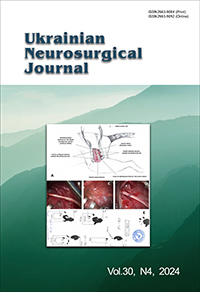The impact of the number of aneurysms on the course of the acute period of subarachnoid hemorrhage in patients with multiple intracranial aneurysms
DOI:
https://doi.org/10.25305/unj.309045Keywords:
subarachnoid hemorrhage, multiple intracranial aneurysms, clinical courseAbstract
Objective to determine the effect of the number of multiple intracranial aneurysms (MIA) on the course of the acute period of subarachnoid hemorrhage (SAH).
Materials and methods: A cross-sectional retrospective study was conducted involving 92 patients in the acute phase of SAH due to the rupture of MIA. Patients were divided into two groups depending on the number of aneurysms. Demographic indicators (age, gender) and clinical-instrumental factors (comorbidities, extent of hemorrhage, severity at admission, clinical manifestations), treatment characteristics, and outcomes were analyzed using descriptive statistics and logistic regression.
Results: Comorbidities were 3.4 times more common among patients with three or more aneurysms (p=0.143). Patients in group 2 were 1.9 times more likely to be admitted with a World Federation of Neurosurgical Societies (WFNS) grade 2 (p=0.335). WFNS grade 3 at admission was observed twice as often in group 1 (p=0.447). Patients from group 1 and group 2 were equally likely to present with WFNS grade 4 (p=0.978). The probability of being admitted with a WFNS grade 5 was 1.8 times higher in group 2 (p=0.830). The presence of meningeal syndrome increased the risk of having 3 or more aneurysms by more than four times (OR 4.41, CI 0.41-47.13, p=0.21). The presence of motor impairments significantly reduced the risk of having 3 or more aneurysms (OR 0.63, CI 0.09-4.18, p=0.63). Patients in group 2 were slightly more likely to develop vasospasm than those in group 1 (OR 1.22, CI 0.34-4.31, p=0.752). The presence of comorbidities increased with the number of aneurysms (OR 3.42, CI 0.65-17.62, p=0.143).
Conclusions: The presence of comorbidities more than triples the chances of having 3 or more aneurysms. Patients with fewer aneurysms are twice as likely to be admitted in a milder condition (WFNS grade 2). The probability of severe condition (WFNS grade 5) at hospital admission for patients in group 2 is 1.8 times higher than in group 1. The likelihood of motor disorders decreases by 4.4 times with an increasing number of aneurysms. The probability of vasospasm development slightly increased with the number of aneurysms. These data emphasize the importance of a comprehensive approach to the assessment of SAH patients and the need for careful monitoring of patients at high risk of vasospasm.
References
1. Li Y, Bai X, Tu H, Zou Z, Huang Y, Cai J. Multiple intracranial enlarging dissecting aneurysms: a case report. BMC Neurol. 2023 Jul 12;23(1):265. [CrossRef] [PubMed] [PubMed Central]
2. Deniwar MA. Management of multiple and unruptured cerebral aneurysms. Egypt J Neurosurg. 2022;37:26. [CrossRef]
3. Bakker MK, Ruigrok YM. Genetics of Intracranial Aneurysms. Stroke. 2021 Aug;52(9):3004-3012. [CrossRef][PubMed]
4. Schilling AM, Heidenreich JO, Oldenburg AC, Pietilä T, Stendel R, Wolf KJ. Multiple cerebral aneurysms in factor VII deficiency. AJNR Am J Neuroradiol. 2004 May;25(5):784-6. [PubMed] [PubMed Central]
5. Wang S, Wang J, Niu Z, Zhang K, Yang T, Hou S, Lin N. Causal relationship between mitochondrial-associated proteins and cerebral aneurysms: a Mendelian randomization study. Front Neurol. 2024 Jul 17;15:1405086. [CrossRef] [PubMed] [PubMed Central]
6. Grochowski C, Litak J, Kulesza B, et al. Size and location correlations with higher rupture risk of intracranial aneurysms. J Clin Neurosci. 2017; S0967586817314479. [CrossRef]
7. Sato T, Matsushige T, Chen B, Gembruch O, Dammann P, Jabbarli R, Forsting M, Junker A, Maderwald S, Quick HH, Ladd ME, Sure U, Wrede KH. Correlation Between Thrombus Signal Intensity and Aneurysm Wall Thickness in Partially Thrombosed Intracranial Aneurysms Using 7T Magnetization-Prepared Rapid Acquisition Gradient Echo Magnetic Resonance Imaging. Front Neurol. 2022 Feb 18;13:758126. [CrossRef] [PubMed] [PubMed Central]
8. Jiang H, Weng YX, Zhu Y, Shen J, Pan JW, Zhan RY. Patient and aneurysm characteristics associated with rupture risk of multiple intracranial aneurysms in the anterior circulation system. Acta Neurochir (Wien). 2016 Jul;158(7):1367-75. [CrossRef] [PubMed]
Downloads
Published
How to Cite
Issue
Section
License
Copyright (c) 2024 Yuliia O. Solodovnikova, Anatoliy S. Son

This work is licensed under a Creative Commons Attribution 4.0 International License.
Ukrainian Neurosurgical Journal abides by the CREATIVE COMMONS copyright rights and permissions for open access journals.
Authors, who are published in this Journal, agree to the following conditions:
1. The authors reserve the right to authorship of the work and pass the first publication right of this work to the Journal under the terms of Creative Commons Attribution License, which allows others to freely distribute the published research with the obligatory reference to the authors of the original work and the first publication of the work in this Journal.
2. The authors have the right to conclude separate supplement agreements that relate to non-exclusive work distribution in the form of which it has been published by the Journal (for example, to upload the work to the online storage of the Journal or publish it as part of a monograph), provided that the reference to the first publication of the work in this Journal is included.









